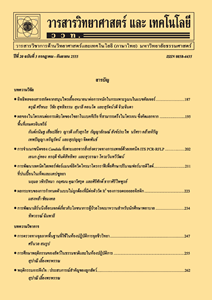บรรจุภัณฑ์ต้านจุลชีพจากเซลลูโลส ไคโตซานและไคโตซานดัดแปร-ซิลเวอร์คอมเพล็กซ์
Main Article Content
Abstract
In this study, new composite materials from cellulose, chitosan, modified chitosan, and immobilized silver ions have been developed to obtain an active packaging. In the first step, modified chitosan was prepared by graft-copolymerization with 2-acrylamido-2-methyl propanesulfonic acid monomer (AMPs) as a chelating agent. The sulfonate group was used in chelation with silver ion for reducing the leakage silver ions from the packaging. Scanning electron microscope (SEM) and X-ray diffraction (XRD) pattern confirmed the presence of silver ions in the cellulose composite. The effects of different concentrations (0.015-0.6 wt%) of silver ions on antimicrobial activity have been investigated. It was observed that the chelation of silver ions resulting in the content of 0.015 wt% showed a good potential for antimicrobial activity against both Gram-positive and Gram-negative bacteria. Furthermore, the chelation with sulfonate groups resulted in about 0.07-0.3 % of silver ions being released from the composite to aqueous solution in the pH range 4-12. In summary, the obtained packaging exhibited very low release of the toxic metal ions. The materials also exhibited good antimicrobial and mechanical properties. Therefore, this composite material displays the potential use as active packaging in food applications.
Article Details
References
[2] Carbone, M., Donia, D.T. Sabbatella, G. and Antiochia, R., 2016, Silver nanoparticles in polymeric matrices for fresh food packaging, J. King Saud Univ. Sci. 28: 237-279.
[3] Zong-ming, X., Qing-bo, Z., Puppala, H., Colvin, V. and Alvarez, P., 2012, Negligible particle-specific antibacterial activity of silver nanoparticles, Nano. Lett. 12: 4271-4275.
[4] Vazquez-Muñoz, R., Borrego, B., Juárez-Moreno, K., García-García, M., Mota Morales, J.D., Bogdanchikova, N. and Huerta-Saquero, A., 2017, Toxicity of silver nanoparticles in biological systems: Does the complexity of biological systems matter?, Toxicol. Lett. 276: 11-20.
[5] Wang, E., Huang, Y., Du, Q. and Sun, Y., 2017, Silver nanoparticle induced toxicity to human sperm by increasing ROS (reactive oxygen species) production and DNA damage, Environ. Toxicol. Pharm. 52: 193-199.
[6] Martinez-Abad, A., Lagaron, J.M. and Ocio, M.J., 2014, Characterization of transparent silver loaded poly(L-lactide) films produced by melt-compounding for the sustained release of antimicrobial silver ions in food applications, Food Control
43: 238-244.
[7] Orsuwan, A. and Sothornvit, R., 2018, Polysaccharide Nanobased Packaging Materials for Food Application, pp. 239-270, Grumezescu, A. and Butu, A. (Eds.), Handbook of Food Engineering Volume 9: Food Packaging and Preservation, 1st Ed., Academic Press, Cambridge, MA.
[8] Lin, S., Chen, L., Huang, L., Cao, S., Luo, X. and Liu, K., 2015, Novel antimicrobial chitosan-cellulose composite films bio conjugated with silver nanoparticles, Ind. Crops Prod. 70: 395-403.
[9] Wu, Z., Huang, X., Li, Y., Xiao, H. and Wang, X., 2018, Novel chitosan films with laponite immobilized Ag nanoparticles for active food packaging, Carbohydr. Polym. 199: 210-218.
[10] Dacrory, S., Abou-Yousef, H., Abouzeid, R.E., Kamel, S., Abdelaziz, M.S. and El-badry, M., 2018, Antimicrobial cellulosic hydrogel from olive oil industrial residue, Int. J. Biol. Macromol. 117: 179-188.
[11] Kumar, S., Shukla, A., Baul, P.P., Mitra, A. and Halder, D., 2018, Biodegradable hybrid nanocomposites of chitosan/gelatin and silver nanoparticles for active food packaging applications, Food Packaging Shelf Life 16: 178-184.
[12] Phetphaisit, C.W., Yuanyang, S. and Chaiyasith, W.C, 2016, Bio-adsorbent from polyacrylamido-2-methyl-1-propane sulfonic acid-graft-natural rubber for heavy metal removal from aqueous standard solution and industrial waste water, J. Hazard. Mater. 301: 163-171.
[13] Cazón, P., Vázquez, M. and Velazquez, G., 2018, Composite films of regenerate cellulose with chitosan and polyvinyl alcohol: Evaluation of water adsorption, mechanical and optical properties, Int. J. Biol. Macromol. 117: 235-246.
[14] Luo, P., Liu, L., Xu, W., Fan, L. and Nie, M., 2018, Preparation and characterization of aminated hyaluronic acid/oxidized hydroxyethyl cellulose hydrogel, Carbohydr. Polym. 199: 170-177.
[15] Huang, Y., Zhang, C., Pan, Y., Zhou, Y., Jiang, L. and Dan, Yi., 2013, Effect of NR on the hydrolytic degradation of PLA, Polym. Degrad. Stab. 98: 943-950.
[16] Gaona-Forero, A., Agudelo-Rodríguez, G., Herrera, A.O. and Castellanos, D.A., 2018, Modeling and simulation of an active packaging system with moisture adsorption for fresh produce: Application in ‘Hass’ avocado, Food Packaging Shelf Life 17: 187-195.
[17] No, H.K., Park, N.Y., Lee, S.H. and Meyers, S.P., 2002, Antibacterial activity of chitosan and chitosan oligomers with different molecular weights, Int. J. Food. Microbiol. 74: 65-72.
[18] Kozicki, M., Kolodziejczyk, M., Szynkowska, M., Pawlaczyk, A., Lesniewska, E, Matusiak, A., Adamus, A. and Karolczak, A., 2016, Hydrogels made from chitosan and silver nitrate, Carbohydr. Polym. 140: 74-87.
[19] Youssef, A.M., Abdel-Aziz, M.S. and El-Sayed, S.M., 2014, Chitosan nanocomposite films based on Ag-NP and Au-NP biosynthesis by Bacillus Subtilis as packaging materials, Int. J. Biol. Macromol. 69: 185-191.
[20] Yetimoglu, E.K., Kahraman, M.V., Ercan, O., Akdemir, Z.S. and Apohan N.K., 2007, N-Vinyl pyrrolidone/acrylic acid/2-acrylamido-2-methylpropane sulfonic acid based hydrogels: Synthesis, characterization and their application in the removal of heavy metals, React. Funct. Polym. 67: 451-460.
[21] Govindam, S., Nivethaa, E.A.K., Saravanan, R., Narayanan, V. and Steohen, A., 2012, Synthesis and characterization of chitosan-silver nanocomposite, Appl. Nanosci. 2: 299-303.
[22] Dimitrijevic, R., Cvetkovic, O., Miodragovic, Z., Simic, M., Manojlovic, D. and Jovic, V., 2013, SEM/EDX and XRD characterization of silver nanocrystalline thin film prepared from organometallic solution precursor, J. Min. Metall. Sect. B-Metall. 49(1): 91-95.
[23] Shih, C., Shieh, Y. and Twu, Y., 2009, Preparation and characterization of cellulose/chitosan blend films, Carbohydr. Polym. 78: 169-174.


